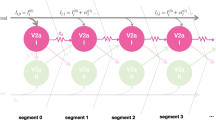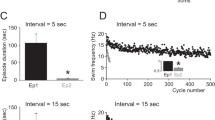Abstract
Animal locomotion results from muscle contraction and relaxation cycles that are generated within the central nervous system and then are relayed to the periphery by motoneurons. Thus, motoneuron function is an essential element for understanding control of animal locomotion. This paper presents motoneuron input–output relationships, including impulse adaptation, in the medicinal leech. We found that although frequency-current graphs generated by passing 1-s current pulses in neuron somata were non-linear, peak and steady-state graphs of frequency against membrane potential were linear, with slopes of 5.2 and 2.9 Hz/mV, respectively. Systems analysis of impulse frequency adaptation revealed a static threshold nonlinearity at −43 mV (impulse threshold) and a single time constant (τ = 88 ms). This simple model accurately predicts motoneuron impulse frequency when tested by intracellular injection of sinusoidal current. We investigated electrical coupling within motoneurons by modeling these as three-compartment structures. This model, combined with the membrane potential–impulse frequency relationship, accurately predicted motoneuron impulse frequency from intracellular records of soma potentials obtained during fictive swimming. A corollary result was that the product of soma-to-neurite and neurite-to-soma coupling coefficients in leech motoneurons is large, 0.85, implying that the soma and neurite are electrically compact.












Similar content being viewed by others
Abbreviations
- MN:
-
Motoneuron
- CPG:
-
Central pattern generator
- DP nerve:
-
Dorsal posterior nerve
References
Buchanan JT (1993) Electrophysiological properties of identified classes of lamprey spinal neurons. J Neurophysiol 70:2313–2325
Button DC, Gardiner K, Marqueste T, Gardiner PF (2006) Frequency–current relationships of rat hindlimb alpha-motoneurones. J Physiol 573:663–677
Fan RJ, Marin-Burgin A, French KA, Friesen WO (2005) A dye mixture (Neurobiotin and Alexa 488) reveals extensive dye-coupling among neurons in leeches; physiology confirms the connections. J Comp Physiol 191:1157–1171
Friesen WO, Hocker CG (2001) Functional analyses of the leech swim oscillator. J Neurophysiol 86:824–835
Gorman RB, McDonagh JC, Hornby TG, Reinking RM, Stuart DG (2005) Measurement and nature of firing rate adaptation in turtle spinal neurons. J Comp Physiol A 191:583–603
Granzow BL, Friesen WO, Kristan WB Jr (1985) Physiological and morphological analysis of synaptic transmission between leech motor neurons. J Neurosci 5:2035–2050
Gustafsson B, Pinter MJ (1984) An investigation of threshold properties among cat spinal alpha-motoneurones. J Physiol 357:453–483
Heckman CJ, Binder MD (1991) Computer simulation of the steady-state input–output function of the cat medial gastrocnemius motoneuron pool. J Neurophysiol 65:952–967
Hocker CG, Yu X, Friesen WO (2000) Functionally heterogeneous segmental oscillators generate swimming movements in the medicinal leech. J Comp Physiol A 186:871–883
Hodgkin AL (1948) The local electric changes associated with repetitive action in a non-medullated axon. J Physiol 107:165–181
Kernell D, Monster AW (1982) Time course and properties of late adaptation in spinal motoneurones of the cat. Exp Brain Res 46:191–196
Kim H, Major LA, Jones KE (2009) Derivation of cable parameters for a reduced model that retains asymmetric voltage attenuation of reconstructed spinal motor neuron dendrites. J Comput Neurosci PMID:19387812
Kristan WB, Calabrese R, Friesen WO (2005) Neuronal control of leech behavior. Prog Neurobiol 76:279–327
Mangan PS, Curran GA, Hurney CA, Friesen WO (1994) Modulation of swimming behavior in the medicinal leech. III. Control of cellular properties in motor neurons by serotonin. J Comp Physiol A 175:709–722
Martin MM (2002) Changes in electrophysiological properties of lamprey spinal motoneurons during fictive swimming. J Neurophysiol 88:2463–2476
Muller KJ, Nicholls JG, Stent GS (1981) Neurobiology of the leech. Cold Spring Harbor Laboratory, Cold Spring Harbor
Ort CA, Kristan WB Jr, Stent GS (1974) Neuronal control of swimming in the Medicinal Leech II. Identification and connections of motor neurons. J Comp Physiol A 94:121–154
Perkel DH, Mulloney B (1978) Electrotonic properties of neurons: steady-state compartmental model. J Neurophysiol 41:621–639
Sawczuk A, Powers RK, Binder MD (1995) Spike frequency adaptation studied in hypoglossal motoneurons of the rat. J Neurophysiol 73:1799–1810
Stuart AE (1970) Physiological and morphological properties of motoneurons in the central nervous system of the leech. J Physiol 209:627–646
Tian J, Iwasaki T, Friesen WO (2006) Static and dynamic components of pacemaker sensitivity in leech motoneurons. Program No. 649.12. Society for Neuroscience, Neuroscience Meeting Planner, Atlanta (online)
Weeks JC (1982) Synaptic basis of swim initiation in the leech. II A pattern-generating neuron (cell 208) which mediates motor effects of swim-initiating neurons. J Comp Physiol A 148:265–279
Zheng M, Friesen WO, Iwasaki T (2007) Systems-level modeling of neuronal circuits for leech swimming. J Comput Neurosci 22:21–38
Acknowledgments
This research was supported by grant NIH/NINDS 1 R01 NS46057-01, part of the National Science Foundation/National Institutes of Health Collaborative Research in Computational Neuroscience Program. Also supported by a grant from the National Science Foundation (IOS-0615631).
Author information
Authors and Affiliations
Corresponding author
Rights and permissions
About this article
Cite this article
Tian, J., Iwasaki, T. & Friesen, W.O. Analysis of impulse adaptation in motoneurons. J Comp Physiol A 196, 123–136 (2010). https://doi.org/10.1007/s00359-009-0499-3
Received:
Revised:
Accepted:
Published:
Issue Date:
DOI: https://doi.org/10.1007/s00359-009-0499-3




